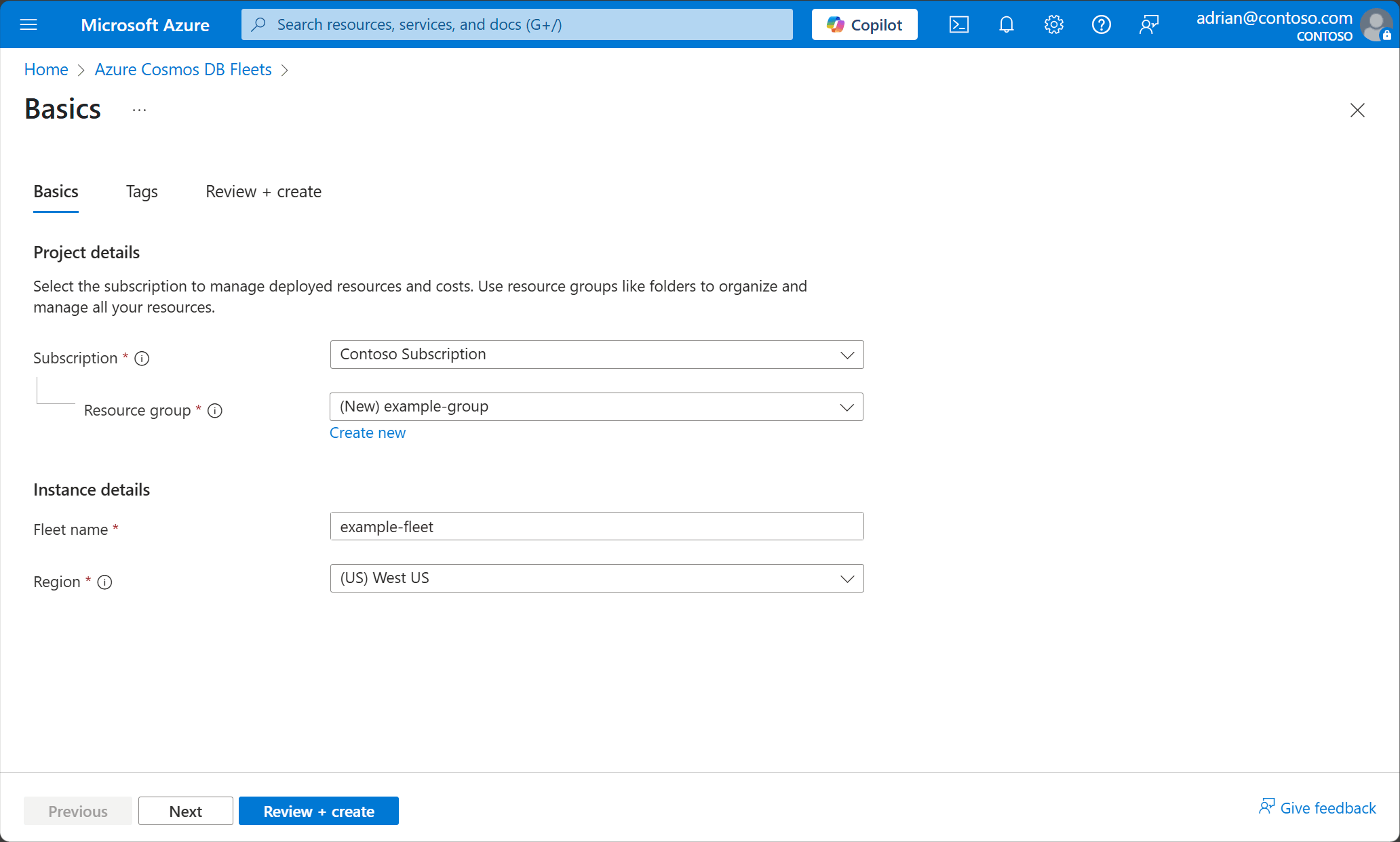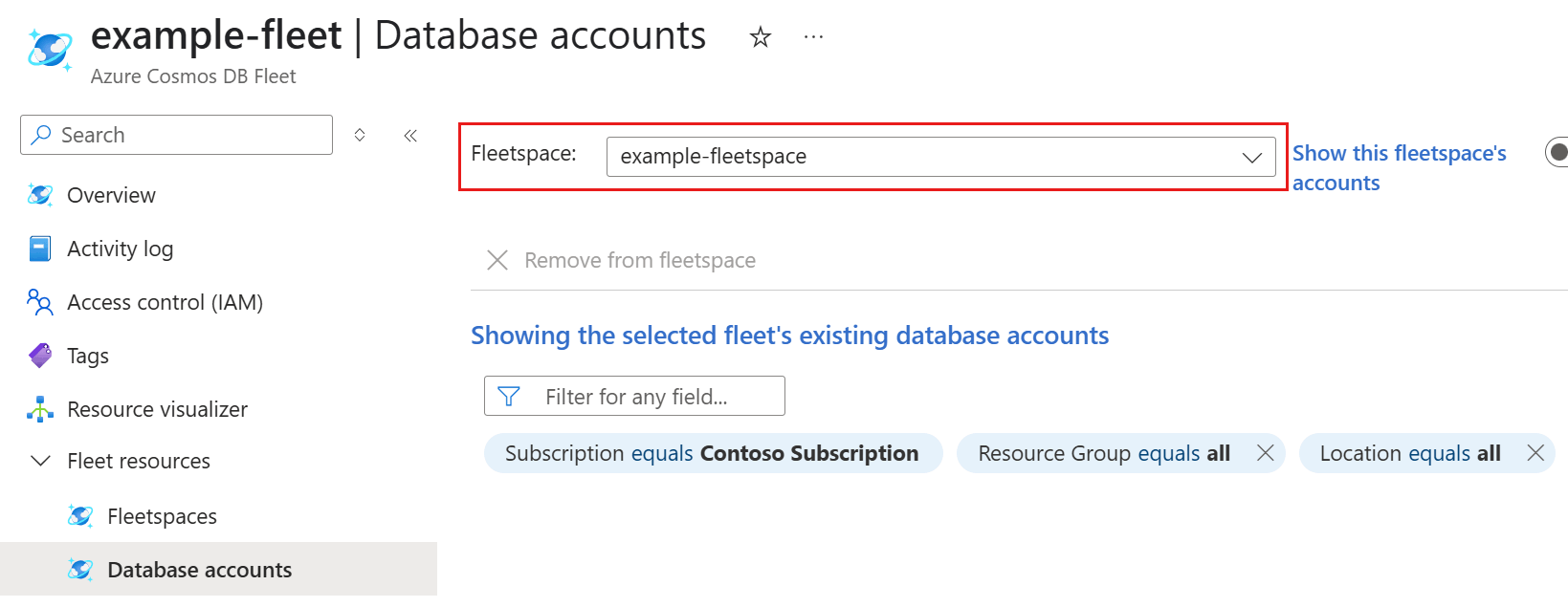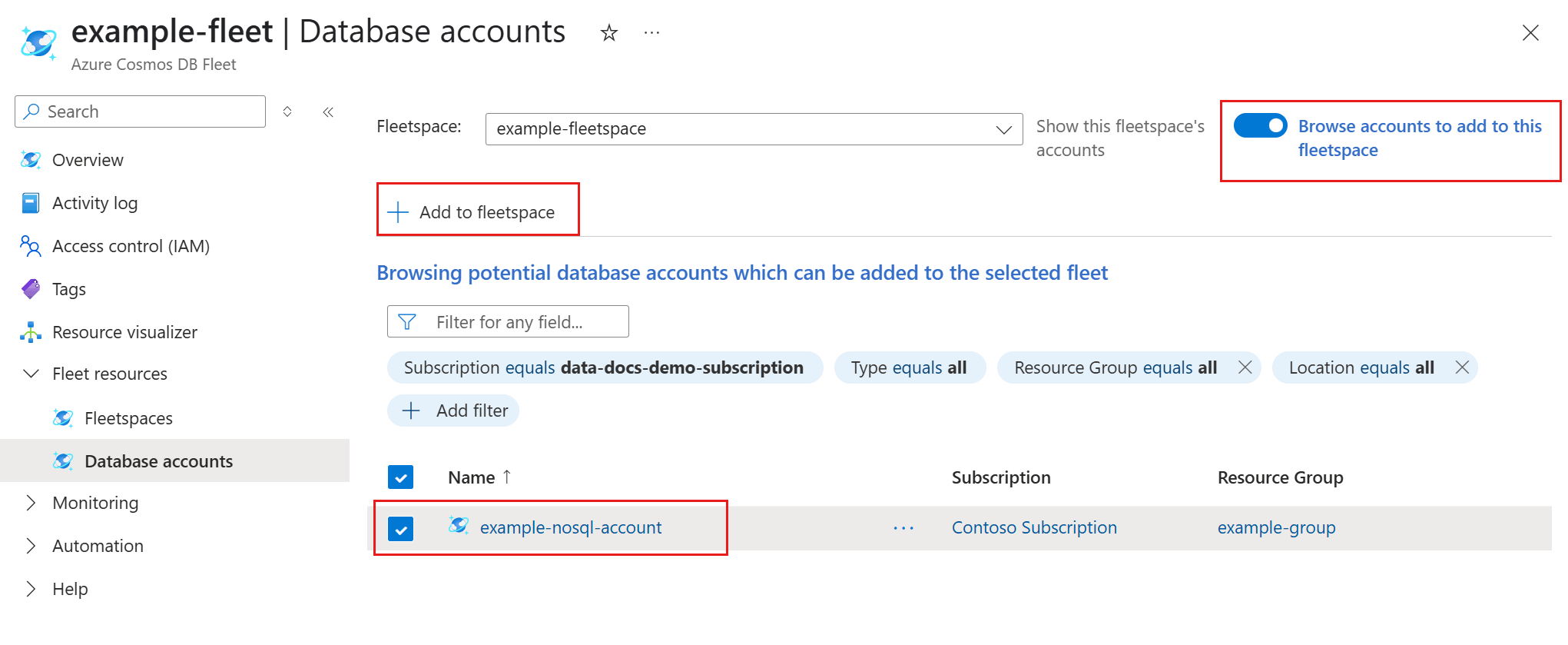Note
Access to this page requires authorization. You can try signing in or changing directories.
Access to this page requires authorization. You can try changing directories.
This article provides step-by-step instructions for creating and managing fleets, fleetspaces, and fleetspace accounts. Follow the guidance here to set up and configure your Azure Cosmos DB fleet resources one-by-one. At the end of this guide, you have a fully configured fleet with a single fleetspace, throughput pooling, and a registered Azure Cosmos DB account as a fleetspace account.
For more information about fleets, see fleets overview.
Prerequisites
An Azure subscription
- If you don't have an Azure subscription, create a Trial before you begin.
- Azure CLI
- Bicep
Create a fleet
Set up your fleet by creating the fleet that eventually contains your fleetspace, and fleetspace account resources. A fleet is a high-level entity that organizes and manages multiple database accounts across different subscriptions and/or resource groups within fleetspaces. One fleet corresponds to one multitenant application. Specify a region and unique name for the fleet.
Note
The region selected for your fleet resources doesn't affect or determine the locations/regions of any database accounts in the fleet.
Sign in to the Azure portal (https://portal.azure.cn).
Enter Cosmos DB fleet in the global search bar.
Within Services, select Azure Cosmos DB Fleets.
On the Azure Cosmos DB Fleets page, select + Create.
Within the Basics pane, configure the following options, and then select Review + create:
Value Subscription Select your Azure subscription Resource group Create a new resource group or select an existing resource group Fleet Name Provide a multiple-regionally unique name Region Select a supported Azure region for your subscription 
On the Review + create pane, wait for validation of your fleet to finish successfully, and then select Create.
Create a fleet using
az resource createand an empty ({}) JSON properties object:az resource create \ --resource-group "<resource-group-name>" \ --name "<fleet-name>" \ --resource-type "Microsoft.DocumentDB/fleets" \ --location "<azure-region>" \ --latest-include-preview \ --properties "{}"Optionally, perform common fleet management operations including:
Retrieving a specific fleet.
az resource show \ --resource-group "<resource-group-name>" \ --name "<fleet-name>" \ --resource-type "Microsoft.DocumentDB/fleets" \ --latest-include-previewListing all fleets within a resource group.
az resource list \ --resource-group "<resource-group-name>" \ --resource-type "Microsoft.DocumentDB/fleets"Deleting a specific fleet.
az resource delete \ --resource-group "<resource-group-name>" \ --name "<fleet-name>" \ --resource-type "Microsoft.DocumentDB/fleets" \ --latest-include-preview
resource fleet 'Microsoft.DocumentDB/fleets@2025-10-25' = {
name: '<fleet-name>'
location: '<azure-region>'
properties: {}
}
Create a fleetspace
Before adding accounts to the fleet, you must create a fleetspace. A fleetspace is a logical grouping of database accounts within the fleet, where RU/s can optionally be shared among all resources in database accounts within the fleetspace. Each database account within a fleet must be a part of a fleetspace.
Note
In this guide, throughput pooling is configured for the fleetspace. You can opt to not use throughput pooling. Throughput pooling is an optional configuration that allows account resources to share RU/s. This shared RU/s is on top of the dedicated RU/s that are already available for the resource.
The pool minimum and maximum RU/s can be changed at any time. The service tier and data regions cannot be changed after fleetspace creation.
To configure throughput pooling for a fleetspace, specify the regions and the service tier that apply to all accounts within the fleetspace. If throughput pooling is configured, all accounts within the fleetspace must share the same regional and service tier configuration.
For more information, see fleet pools.
Navigate to your existing fleet resource within the Azure portal.
Select the Fleetspaces option within the Fleet resources section of the resource menu.
Within the dialog, configure the following options, and then select Ok:
Value Fleetspace name Provide a unique name within your fleet Enable throughput pooling Select the checkbox Select regions for accounts in throughput pool Select and Add a list of regions for accounts in the throughput pool Select write-region type for accounts in throughput pool Select either Single-write region (General purpose) or Multi-write region (Business critical) Throughput pool minimum RU/s A whole number, not less than 100,000, and must be a multiple of 1,000 Throughput pool maximum RU/s A whole number, not less than 100,000, or less than throughputPoolConfiguration.minThroughputand must be a multiple of 1,000
Create a fleetspace within your fleet using the following properties:
Value fleetspaceAPIKindNoSQLthroughputPoolConfiguration.minThroughputA whole number, not less than 100,000, and must be a multiple of 1,000 throughputPoolConfiguration.maxThroughputA whole number, not less than 100,000, or less than throughputPoolConfiguration.minThroughputand must be a multiple of 1,000throughputPoolConfiguration.serviceTierEither GeneralPurposeorBusinessCriticalthroughputPoolConfiguration.dataRegionsList of regions for accounts in the throughput pool json=$(jq \ --arg "locationName" "<azure-region>" \ --arg "api" "NoSQL" \ --arg "minRUs" 100000 \ --arg "maxRUs" 100000 \ --arg "tier" "GeneralPurpose" \ --null-input \ --compact-output \ '{fleetspaceAPIKind:$api,serviceTier:$tier,dataRegions:[$locationName],throughputPoolConfiguration:{minThroughput:$minRUs,maxThroughput:$maxRUs}}' \ ) az resource create \ --resource-group "<resource-group-name>" \ --name "<fleet-name>/fleetspaces/<fleetspace-name>" \ --resource-type "Microsoft.DocumentDB/fleets/fleetspaces/" \ --location "<azure-region>" \ --latest-include-preview \ --properties $jsonTip
You can configure the
minThroughput,maxThroughput,writeRegionType, anddataRegionsproperties to whatever is appropriate for your scenario.Optionally, perform common fleetspace management operations including:
Retrieving a specific fleetspace within a fleet.
az resource show \ --resource-group "<resource-group-name>" \ --name "<fleet-name>/fleetspaces/<fleetspace-name>" \ --resource-type "Microsoft.DocumentDB/fleets/fleetspaces/" \ --latest-include-previewListing all fleetspaces within a fleet.
az resource list \ --resource-group "<resource-group-name>" \ --resource-type "Microsoft.DocumentDB/fleets/fleetspaces/"Deleting a specific fleetspace within a fleet.
az resource delete \ --resource-group "<resource-group-name>" \ --name "<fleet-name>/fleetspaces/<fleetspace-name>" \ --resource-type "Microsoft.DocumentDB/fleets/fleetspaces/" \ --latest-include-preview
| Value | |
|---|---|
fleetspaceAPIKind |
NoSQL |
throughputPoolConfiguration.minThroughput |
A whole number, not less than 100,000, and must be a multiple of 1,000 |
throughputPoolConfiguration.maxThroughput |
A whole number, not less than 100,000, or less than throughputPoolConfiguration.minThroughput and must be a multiple of 1,000 |
throughputPoolConfiguration.serviceTier |
Either GeneralPurpose or BusinessCritical |
throughputPoolConfiguration.dataRegions |
List of regions for accounts in the throughput pool |
resource fleetspace 'Microsoft.DocumentDB/fleets/fleetspaces@2025-10-15' = {
name: '<fleetspace-name>'
parent: fleet
location: '<azure-region>'
serviceTier: 'General Purpose''
dataRegions: [
'<azure-region>'
]
properties: {
fleetspaceAPIKind: 'NoSQL'
throughputPoolConfiguration: {
minThroughput: 100000
maxThroughput: 100000
}
}
}
Tip
You can configure the minThroughput, maxThroughput, writeRegionType, and dataRegions properties to whatever is appropriate for your scenario.
Add accounts to a fleetspace
Once the fleetspace is created, add accounts either to the fleetspace itself. Accounts from any subscription/resource group can be added to the fleet. When pooling is configured for the fleetspace, these resources consume RU/s from the pool.
Important
You can't add accounts to your fleetspace that are already associated with an existing fleetspace.
Select the Database accounts option within the Fleet resources section of the resource menu.
In the Fleetspace section, select an existing fleetspace.

Then, enable the Browse accounts to add to this fleetspace option.
Select an existing Azure Cosmos DB for NoSQL account and then select + Add to fleetspace.

Create a fleetspace account within your fleetspace using the following properties:
Value accountLocationLocation for the Azure Cosmos DB account. accountResourceIdentifierFully qualified resource identifier for the target Azure Cosmos DB account. databaseResourceId=$(az resource show \ --resource-group "<resource-group-name>" \ --name "<azure-cosmos-db-resource-name>" \ --resource-type "Microsoft.DocumentDB/databaseAccounts" \ --query "id" \ --output tsv \ ) json=$(jq \ --arg "locationName" "<azure-region>" \ --arg "accountResourceId" "$databaseResourceId" \ --null-input \ --compact-output \ '{accountLocation:$locationName,accountResourceIdentifier:$accountResourceId}' \ ) az resource create \ --resource-group "<resource-group-name>" \ --name "<fleet-name>/fleetspaces/<fleetspace-name>/fleetspaceAccounts/<fleetspace-account-name>" \ --resource-type "Microsoft.DocumentDB/fleets/fleetspaces/fleetspaceAccounts/" \ --location "<azure-region>" \ --latest-include-preview \ --properties $jsonOptionally, perform common fleetspace management operations including:
Retrieving a specific fleetspace account within a fleetspace.
az resource show \ --resource-group "<resource-group-name>" \ --name "<fleet-name>/fleetspaces/<fleetspace-name>/fleetspaceAccounts/<fleetspace-account-name>" \ --resource-type "Microsoft.DocumentDB/fleets/fleetspaces/fleetspaceAccounts/" \ --latest-include-previewListing fleetspace accounts within a fleetspace.
az resource list \ --resource-group "<resource-group-name>" \ --resource-type "Microsoft.DocumentDB/fleets/fleetspaces/fleetspaceAccounts/"Deleting a specific fleetspace account.
az resource delete \ --resource-group "<resource-group-name>" \ --name "<fleet-name>/fleetspaces/<fleetspace-name>/fleetspaceAccounts/<fleetspace-account-name>" \ --resource-type "Microsoft.DocumentDB/fleets/fleetspaces/fleetspaceAccounts/" \ --latest-include-preview
| Value | |
|---|---|
accountLocation |
Location for the Azure Cosmos DB account. |
accountResourceIdentifier |
Fully qualified resource identifier for the target Azure Cosmos DB account. |
resource account 'Microsoft.DocumentDB/databaseAccounts@2024-12-01-preview' existing = {
name: '<azure-cosmos-db-resource-name>'
}
resource fleetspaceAccount 'Microsoft.DocumentDB/fleets/fleetspaces/fleetspaceAccounts@2025-10-15' = {
name: '<fleetspace-account-name>'
parent: fleetspace
location: '<azure-region>'
properties: {
accountLocation: '<azure-region>'
accountResourceIdentifier: account.id
}
}